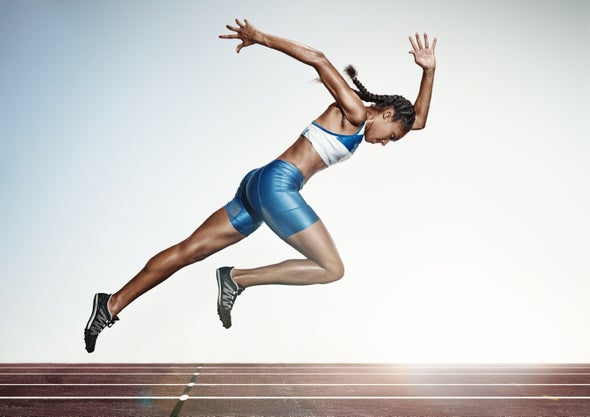(单词翻译:单击)
听力文本
This is Scientific American — 60-Second Science. I'm Karen Hopkin.
The microbes in our intestines help keep us healthy, strengthening our immune systems and promoting metabolism. But they may also give us a leg up when it comes to moving our legs up—and down again, rapidly and repeatedly—because a new study finds that mice that are fed bacteria isolated from elite athletes log more time on the treadmill than other mice that are treated only to bacteria found in yogurt. The results appear in the journal Nature Medicine.
Aleksandar Kostic, a microbiologist at Harvard Medical School, was initially interested in how the gut microbes of people with diabetes might differ from folks without the condition—the idea being that tweaking the microbiome might help to treat the disease. But the question of enhancing overall health and fitness can also come from the other direction:
"But here the question was more, what's unique in the gut microbiome of someone who is supremely healthy? And can we use that feature of the microbiome to transfer into other people to potentially make them healthier?"
And a handy window into the gut is poop. So Kostic and his crew asked 15 runners who competed in the Boston Marathon in 2015 to provide daily stool samples from a week before the race to a week after. They also collected samples from 10 people who are decidedly more sedentary, and they tallied the bacteria present in each.

"And when we looked at this data, there was really one thing that really jumped out at us, and it was this genus of bacteria that isn't so well studied: Veillonella. We found that it was very significantly higher in abundance in the gut after the marathon. But not only that, it was found much more frequently in elite marathon runners than in the general population."
To see whether this microbe might provide the athletes with any benefit, they gave some to mice and then let the little rodents run. And they found that the mice loaded with Veillonella spent more time on the treadmill than those that got Lactobacillus.
"And this was an increase of 13 percent... I think any endurance athlete or any athlete in general will tell you that a 13 percent increase is pretty significant."
Now, the interesting thing about Veillonella is that they thrive on lactate, which is a chemical produced by fatigued muscle. The bacteria consume lactate and convert it into a fatty acid called propionate. Then mice that were treated to proprionate, which was delivered via teeny tiny enemas to mimic its release by gut bacteria, similarly extended their treadmill time.
"And so this creates a kind of a positive feedback loop and helps us to understand why Veillonella might be enriched in elite athletes in the first place."
Exercise produces lactate, which feeds Veillonella. Veillonella produces propionate, which somehow promotes endurance, at least in treadmill-trotting mice. Which means that gut microbes may hold the secret to extending that workout—without getting pooped.
Thanks for listening for Scientific American — 60-Second Science. I'm Karen Hopkin.
参考译文
这里是科学美国人——60秒科学。我是凯伦·霍普金。
我们肠道中的微生物帮助我们保持健康,增强我们的免疫系统,并促进新陈代谢。但当我们的腿迅速且频繁地提起放下时,微生物可能也会帮助我们,因为一项新研究发现,与仅喂食酸奶中所含细菌的老鼠相比,被喂食从优秀运动员体内所分离细菌的老鼠,在跑步机上坚持的时间更长。研究结果发表在《自然医学》期刊上。
哈佛医学院的微生物学家亚历山大·库斯迪最初感兴趣的是,糖尿病患者的肠道微生物与没有糖尿病者的有何不同——想法是,调整微生物群可能有助于治疗糖尿病。但增强整体健康和体格的问题也可能来自另一个方向:
“但这里的问题更多,极其健康的人的肠道微生物群有何独特之处?我们能否利用微生物群的这一特性将其转移到其他人身上,使他们更健康?”
进入肠道的便利方法是大便。因此,库斯迪及其团队要求参加2015年波士顿马拉松的15名选手在比赛前后一周提供每日粪便样本。他们还收集了10个明显久坐不动者的样本,并计算了每个样本中的细菌数量。
“我们观察这些数据时,确实有一件事引起了我们的注意,那就是未经深入研究的细菌:韦荣氏球菌属。我们发现,在马拉松比赛后,选手肠道中这种细菌的含量显著提高。不仅如此,与普通人相比,在马拉松优秀选手体内发现这种细菌的频率要高得多。”
为了研究这种微生物是否会为运动员提供好处,他们给老鼠注射了一些细菌,然后让这些小型啮齿类动物奔跑。他们发现,与携带乳酸菌属的老鼠相比,携带韦荣氏球菌属的老鼠在跑步机上奔跑的时间更长。
“时间增加了13%……我认为任何耐力运动员或一般的运动员都会告诉你,增长13%意义非凡。”
韦荣氏球菌属的有趣之处在于,它们靠乳酸生长,乳酸是疲劳的肌肉产生的一种化学物质。韦荣氏球菌属消耗乳酸,并将其转化为名为“丙酸盐”的脂肪酸。老鼠被注入丙酸盐,即用微量灌肠剂传递该物质,模拟肠道细菌释放丙酸盐的过程,这同样延长了老鼠在跑步机上的奔跑时间。
“因此,这创造了一种正反馈循环,并帮助我们理解,为什么韦优秀运动员体内一开始就有大量荣氏球菌属。”
锻炼产生乳酸,乳酸可以喂养韦荣氏球菌属。韦荣氏球菌属产生丙酸盐,这在某种程度上提升了耐力,至少对在跑步机上跑步的老鼠来说如此。这意味着肠道微生物可能掌握着延长锻炼时间且不会精疲力竭的秘密。
谢谢大家收听科学美国人——60秒科学。我是凯伦·霍普金。
译文为可可英语翻译,未经授权请勿转载!
重点讲解
重点讲解:
1. jump out at sb. 极易引起注意;
A phrase jumped out at me in a piece about copyright.
在一篇有关版权的文章中,有一个短语引起了我的注意。
2. in abundance 大量;丰盛;充裕;
Fruit and vegetables grew in abundance on the island.
该岛盛产水果和蔬菜。
3. convert into (使)改变;更改;(使)转变;
The signal will be converted into digital code.
信号会被转变为数字代码。
4. in the first place 起初;一开始;
I don't think we should have been there in the first place.
我认为我们从一开始就不该在那儿。


